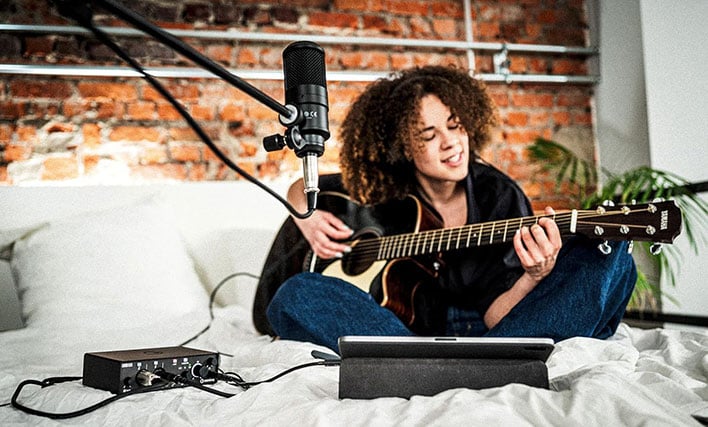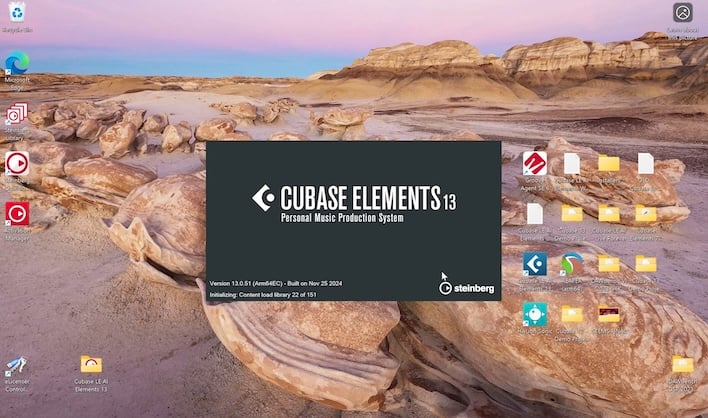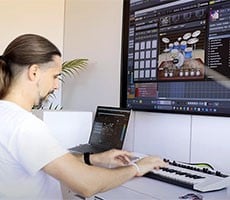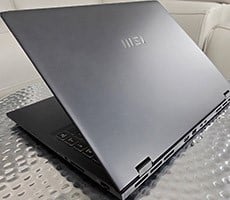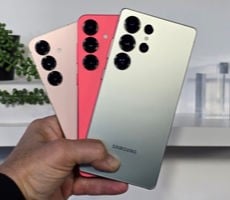Snapdragon Laptop Rocks Steinberg Cubase For Music Production
Steinberg, Qualcomm And Microsoft Joined Forces For Musicians, So We Explored A Snapdragon DAW
We got our mitts on everything needed to make music on a Snapdragon-powered Windows laptop, around the same time that Qualcomm's PJ Jacobowicz went on our Two And A Half Geeks podcast. The enabling bundle of tech we used is a Steinberg IXO22 Recording Pack, which includes a Steinberg IXO audio interface, a copy of Cubase AI, a microphone, and a pair of headphones.
This isn't really a review of this kit of hardware, but it's a pretty solid way for beginners to get into the world of audio production. The microphone is a large-diaphragm condenser, the ST-M01, and the ST-H01 headphones are large over-ear cans with closed backs. Neither are available separately, and they're not the greatest, but they're not bad. It goes up against a ton of similarly-priced entry-level packs from the likes of Presonus and Focusrite.
Fixing Low Latency Audio On Windows
Everyone probably knows that latency is more or less a delay. Input latency in classic video games (and some modern titles) can spell the difference between life and death, especially if there's a significant time that passes between a button press and on-screen action. In the audio world, delay happens in two directions -- both input and output, and the sum of those two latencies is referred to as a round trip latency. It's usually measured in milliseconds, and the number of milliseconds doesn't need to get all that high before it's noticeable. If you want to experience what it's like to make music with high-latency audio, just download a speech jammer app for your smartphone. It's incredibly hard to record.Fortunately, most audio interfaces, including the IXO22, support direct monitoring. That means that rather than sending audio to the computer and waiting for it to be processed and come back down the USB line, the interface just plays the "dry" signal through your headphones or studio monitors. That's an okay experience that has effectively no latency, but sometimes having a "wet" signal that's been pushed through a compressor, a nice hall reverb, and a touch of chorus can be inspiring for the musician. On Windows, the ASIO driver API is how that's handled industry-wide. For most manufacturers, those low-latency drivers only work on x86 Windows machines, and often times latency was not great. That's all in the midst of changing, though, as we'll show you live here in our in-house demo...
Qualcomm, Microsoft, and Steinberg collaborated on drivers for Windows on Arm together, and the fruits of that labor actually produced a couple of varieties. Of course, there is now an Arm-native low-latency driver for Steinberg USB audio interfaces. That driver is built with the exact hardware configurations in mind and can generate some impressively low round trip times. We did our testing on a Samsung Galaxy Book4 Edge, which has the Snapdragon X1 Elite 100-84 on board, which is the fastest of the X1E family. We had no problem using the lowest buffer length of 32 samples.
At a playback rate of 44.1 kHz, 32 samples of buffer is just 0.7 milliseconds, but with hardware and driver overhead, it ends up being more like 2.7 ms. Add that to around 1.7 ms of input delay and we get a round trip of less than 5 milliseconds. The speed of sound is 343 meters per second, so that's equivalent to standing around 1.7 meters away from a speaker, at 5 milliseconds. You can kind of eyeball that measurement in feet by equating one millisecond with one foot. At any rate, that's all to say that you're in the same room, and your sound is effectively instantaneous.
On top of the proprietary USB driver, a USB class driver for audio devices also sprang forth from this collaboration. That means Windows now has an ASIO driver for just about any USB audio device, which makes using a DAW without installing proprietary drivers much more feasible. This isn't optimal, however, as round trip latencies aren't quite as good, more like 15-20 millisecond round trip, depending on the interface we tried. Regardless, we had good success with our Presonus AudioBox iTwo using the generic driver with a total round-trip latency of 17.7 milliseconds. That's still around 3x as long as using the Yamaha driver, and on an x86 PC, that same interface can do much better with Presonus's driver. Still, that's an incredible leap, considering that non-ASIO performance is more like a full second of delay.
Macs have always had the upper hand in audio production, and Apple extended its market share when Core Audio generic drivers for USB interfaces got the latencies very low without any custom drivers. This is why all of our Mac reviews over the last couple of years have included Logic Pro X performance; Core Audio makes it easy to get a DAW up and running without additional special software. Regardless, this new ASIO driver for Windows levels the playing field with Apple. It also levels the playing field for x86 owners, since this will be included as a part of Windows in mid-2025 for both Snapdragon PCs as well as those with AMD and Intel chips.
Cubase For Windows On Snapdragon Preview
All the hardware and drivers in the world aren't really enough if you don't have a solid DAW to use for recording, editing, mixing, and mastering. Right now there are three available in preview for Snapdragon laptops. Steinberg's Cubase Elements 13 and Nuendo (which is more post-production focused rather than music) and Cockos Reaper 7 are all available to try for yourself right now. Reaper is widely used by bedroom studio artists around the world, thanks to its powerful feature set and low price, but it doesn't include much for effects in the box. That's normally no big deal, but VST (Virtual Studio Technology) plugins for Arm are still in their infancy, so beyond just recording and editing there's not much mixing going on.Instead, we stuck to Cubase. You might be aware that Cubase 14 was released late last year, but the Arm/Snapdragon preview is still on the v13 codebase. As Steinberg gets closer to release, the Yamaha subsidiary will presumably announce a version of Cubase 14 as well. We tested in Cubase Elements 13, which comes bundled with a wide array of VST effects plug-ins as well as multiple virtual instruments, including HALion, Groove Agent SE, and Iconia Sketch.
If you've watched the video above, you're already aware that these apps and plug-ins work at very low latencies as well. The thing is, it's more than just the driver that determines latency. Every plug-in requires some amount of time to process the incoming audio stream, and there are often multiple plugins across multiple tracks. That can add up over time. As we worked, it wasn't enough to overwhelm our 32-sample buffer.
We worked pretty hard to try to overwhelm the system as well. Steinberg has a large collection of demo projects with 50+ tracks available for download. The performance of our Galaxy Book4 Edge was roughly on par with a reference desktop PC running a Core i7-13700K and the latest Raptor Lake microcode. In our testing, we observed 10-15% overall CPU load, without any one core getting too overwhelmed to introduce pops and clicks, all with a 32-sample buffer at 44.1 kHz. As more and more DAWs and VST plug-ins are released, and as hardware manufacturers start making their own Arm-native drivers, Snapdragon X1 Elite laptops will be a very solid choice for digital music production.
The Road Ahead For Digital Audio Workstations
The unfortunate thing is that so much of what we've talked about today is still a little ways into the future. The USB Class ASIO driver is a few months out. Cubase, Nuendo, and Reaper support is right now just in preview, although new builds become available for testing at a rapid pace. Other hardware manufacturers beyond Steinberg haven't released any sort of proprietary driver for Windows on Arm just yet, though Focusrite promises it will make proprietary ASIO drivers early this year. Despite the future focus, what we've seen to date is a far sight better than the state of audio production on Arm-based or even Windows PCs in the past.There's also more that kind of extends beyond this one collaboration that's coming, too. Microsoft says a new Windows MIDI service version 2.0 is also due to ship alongside the generic ASIO driver in 2025. MIDI is actually pretty cumbersome to get working well at a system level on macOS, so this is a place Microsoft could make things easier than the status quo. Reason Studios says it will bring its Reason software (which works as a standalone performance tool as well as a VST plug-in version) to WoA.
Unfortunately, despite this many announcements, there are some very notable absences from the list. Native Instruments makes Reakt, Guitar Rig, and a bunch of other widely used sound libraries. Universal Audio makes premium audio interfaces and VST plug-ins. And despite its detractors, Avid's Pro Tools is still the default industry standard in recording studios around the world. None of these companies have any public statements about Arm-native software so far. They're may be waiting for more users to demand it, while these companies' customers might be waiting for support before jumping. It could very well be a chicken-and-egg scenario, but Qualcomm is very active and committed to helping developers make this leap.

